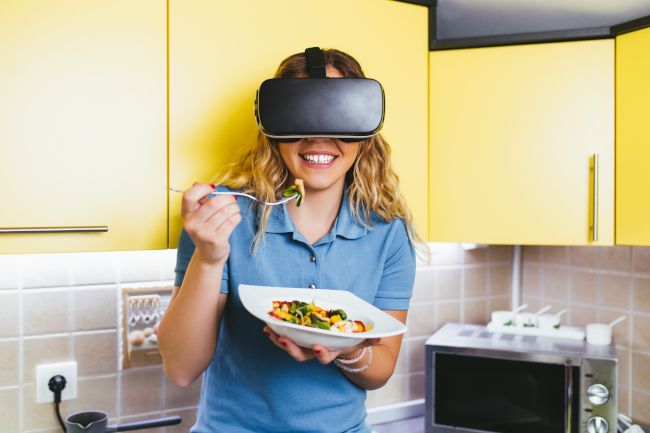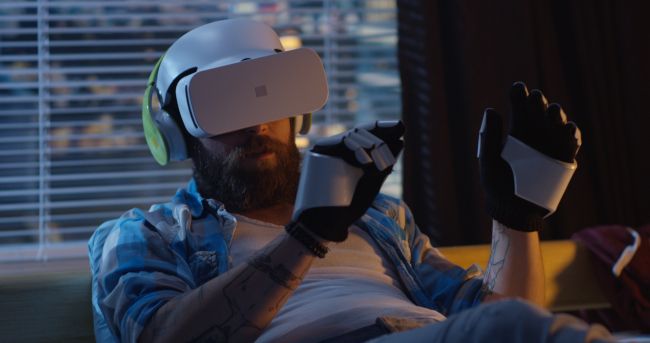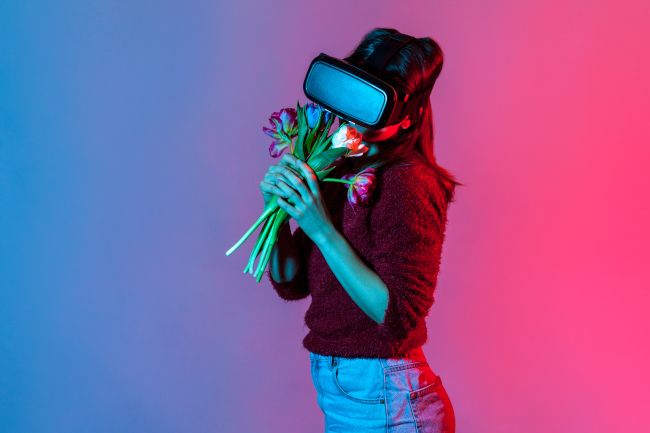
Exploring Next-Gen Virtual Reality: The Quest for True Multi-Sense Immersion with Taste, Touch, and Smell Features

Exploring Next-Gen Virtual Reality: The Quest for True Multi-Sense Immersion with Taste, Touch, and Smell Features
Quick Links
- It’s Not As Crazy As It Smells
- Simulated Taste: All Flavor, No Calories
- Next-Generation Haptics
- Smelling the Virtual Roses
- The Holy Grail: Direct Brain Stimulation
Virtual Reality (VR) has pretty much nailed providing high-quality virtual content for your eyes and ears, but what about the other sense organs? How far away are we from getting taste, touch, and smell as part of the VR experience?
It’s Not As Crazy As It Smells
Do we really need more than just the sights and sounds of modern VR? It’s true that the state of VR as it is today is highly immersive. VR systems have achieved something known as “presence “, where the user’s brain really is fooled into thinking you’re in the virtual world and not standing in front of a very confused cat in your living room.
Related: What Is “Presence” in VR, and Why Is it So Important?
So adding in more sources of virtual sensory information isn’t about achieving immersion, but more about coloring in that virtual world so that it becomes every more like the real world.
It’s not as if the idea of adding these sensory channels to media is new. Movie theaters have experimented with releasing smells during certain scenes. There have been video games known as “feelies “ where you’d get items in the box that you’re supposed to touch when instructed. It may have been largely a gimmick in the past, but many people hold that opinion of VR itself as well, so there’s certainly a market for more.
Simulated Taste: All Flavor, No Calories

You can hop into a VR experience like VRChat, order a virtual hot dog, pick it up, and look at it, but you can’t taste it. While it might not be a headline feature on VR users’ wishlists, simulating the sense of taste is something that engineers and scientists have been working on for a long time.
Taste is an incredibly complex sense. Your tongue is covered in chemical receptors known as taste buds. So you’d think that in order to simulate different tastes, you’d need technology that mixes together a few fundamental taste chemicals and then introduces them to your tongue. You might imagine it like the way an inkjet printer can make any color from a small number of primary colors.
It turns out, this might not be necessary at all for taste. Researchers have found that you can use electrical or thermal stimulation to induce a sense of taste. These approaches are still in the very early phases, but perhaps one day you’ll stick a plate in your mouth when you suit up for VR and enjoy a range of tastes.
Next-Generation Haptics

Frame Stock Footage/Shutterstock.com
You can already feel things in VR thanks to advanced haptic hardware. Linear Resonant Actuators in VR controllers can convincingly reproduce the feeling of bumping into something, and force-feedback devices such as racing wheels or motorized VR gloves can recreate the sensation of driving over different surfaces or the shapes of objects.
These advanced haptic systems are only for those with access to disposable income, and software support for the exotic stuff is thin on the ground. But the state of the art is actually almost there for crude- to medium- fidelity touch.
In 2013, Disney developed a screen that could recreate textures using electronic pulses. So if there was a picture of a fish on screen, it would feel slimy and slippery to the touch. A dog, on the other hand, would feel furry.
More recently, the Interhaptics Engine can reproduce a wide range of texture sensations by using pulses that can fool the mechanoreceptors in your fingertips into thinking they’re touching something with a particular surface texture. The engine is also capable of driving sensations such as stiffness, vibration, and temperature.
In other words, we’re on track to create technology that can reliably recreate many types of touch sensations that current consumer VR can’t. Getting the cost and complexity down so that it can reach the masses, however, will take time.
Smelling the Virtual Roses

Of all the senses besides sight and sound, smell might be the most important and impactful one. Smell is actually a strong trigger of memory , which suggests they’re important to memory in general. Most of what we think of as “flavor” is actually smell as well. If you pinch your nose shut, you can still tell basic tastes such as sweet or bitter apart, but complex flavors go away. It’s the complex chemical sensors in your nose combined with the tongue that really makes taste what it is.
Recreating smell might be the hardest goal here, but it depends on whether you want to be able to recreate every possible smell, or only a relatively small number of them. A company called OVR is working on a smell system for VR that uses chemical reproductions of various smells. For example, the smell of diesel fumes or smoke to be used for military training in VR.
A company named Feelreal has promised to release Sensory Masks for all of the major VR headsets . This mask, along with compatible software, can recreate smell, temperature, water mist, and vibration in the headset.
For smell specifically, the mask uses nine cartridges with different aromas that can be mixed together. These can be depleted and need to be replaced, but by combining them in various proportions this “scent generator” can offer a bouquet of smells.
However, Feelreal has been plagued with issues and at the time of writing not yet released products to the public. Their Kickstarter page has gone some time without an update, following multiple updates detailing issues with the FDA’s vaping liquid ban, which would include Feelreal’s technology. Their Kickstarter updates further detail issues resulting from the 2020 COVID lockdowns. While their last update as of this article’s publication claims that the project is still alive, it’s not clear whether the project is permanently halted or not.
The Holy Grail: Direct Brain Stimulation
All of the technologies that are trying to bring more sensations to VR work by fooling our sensory organs, but perhaps one day we’ll recreate these sensations by bypassing those organs altogether. Direct brain stimulation through a future brain implant similar to the current Neuralink or Braingate systems might allow a computer system to let you feel anything. Yes, that sounds like The Matrix, but it’s still a real possibility if the right breakthroughs are made. However, we’d be very hesitant to put any date on it, since too many factors are in play.
As for taste, touch, and smell technologies, they’re already here and some can even be purchased. So don’t be surprised if the next decade introduces taste, touch, or smell simulations that you can experience it for yourself.
Also read:
- [New] 2024 Approved Top Players for YouTube on iOS and Android Compared
- [New] The Best Way to Record a PowerPoint Presentation
- Best Fixes For Poco C50 Hard Reset | Dr.fone
- Complete Tutorial for Motorola Moto E13 Hard Reset | Dr.fone
- DIY Tutorial: Embedding Custom Watermarks Into Your PDF Files for Enhanced Security
- How to Update Apple iPhone 13 Pro without Losing Anything? | Dr.fone
- In 2024, The Most Useful Tips for Pokemon Go Ultra League On OnePlus 12R | Dr.fone
- Resolving 'Authentication Expired' On YouTube: A Step-by-Step Guide
- Simple ways to get lost messages back from Oppo Find N3 Flip
- Study Reveals Key Players in Covid Myth Spread
- Use Device Manager to identify missing drivers with Windows Device Manager in Windows 11/10/7
- Xiaomi 13 Ultra won’t play HEVC H.265 media, how to fix?
- シームレスな移行: Windows 10をWindows 8.1/7に効率的にダウングレード
- Title: Exploring Next-Gen Virtual Reality: The Quest for True Multi-Sense Immersion with Taste, Touch, and Smell Features
- Author: Ian
- Created at : 2025-02-15 22:56:09
- Updated at : 2025-02-19 21:33:12
- Link: https://techidaily.com/exploring-next-gen-virtual-reality-the-quest-for-true-multi-sense-immersion-with-taste-touch-and-smell-features/
- License: This work is licensed under CC BY-NC-SA 4.0.